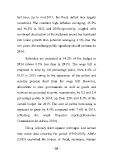Page 546 - 2016 - Vol. 40
P. 546
last year, up to mid-2013, the fiscal deficit was largely
monetized. The resultant high inflation averaging, 35.5%
and 36.2% in 2012 and 2013respectively, coupled with
continued devaluation of the Sudanese pound has translated
into lower growth than potential averaging 2.5% over the
two years. Streamlining public spending should continue in
2014.
Subsidies are projected at 14.2% of the budget in
2014 (about 6.3% less than in 2013). The wage bill is
projected to drop by 0.8 percentage point, from 4.4% of
GDP in 2013 owing to the separation of the police and
security pension fund from the wage bill. However,
allocations to state governments as well as goods and
services are projected to grow, respectively, by 5.2 and 2.4
percentage points in 2014, up from 22% and 8.3% of the
overall budget for 2013. The cost of public borrowing is
expected to grow by 8.9% compared with 7.6% in 2013,
reflecting the weak financial market.(Economic
Commission for Africa, 2014).
Using ordinary least squares technique and annual
time series data covering the period (1990-2010), Alfaki
(2013) examined the impact of fiscal, monetary, foreign
- 58 -

